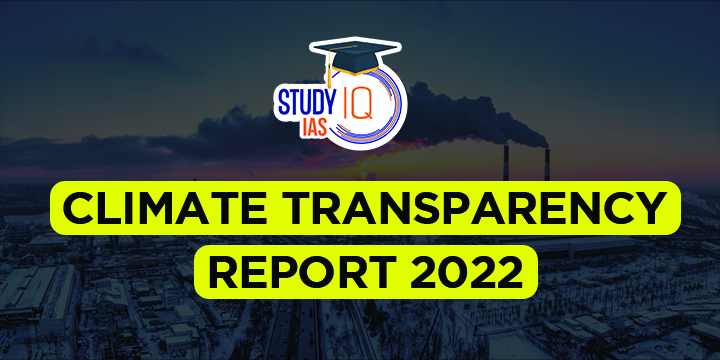Table of Contents
What is the Climate Transparency Report 2022
About: The Climate Transparency Report is the world’s most comprehensive annual review of G20 countries’ climate action and their transition to a net zero emissions economy.
Theme for the 2022 edition: G20 response to the energy crisis: Critical for 1.5°c.
Prepared by: The report was developed by experts from 16 partner organizations from the majority of the G20 countries.
Significance: The Climate Transparency Report 2022 report especially highlights the link between the climate emergency and energy crisis.
Climate Transparency Report 2022: Major Findings for India
- Emissions Overview
- Total emissions: India’s total greenhouse gas emissions (excluding LULUCF) have increased by 182% (1990–2019). The increases were largely due to a sustained increase in energy-related emissions.
- LULUCF stands for Land Use, Land-Use Change and Forestry.
- Per capita emissions: India’s per capita emissions (including LULUCF) are approximately 30% of the G20 average. Total per capita emissions have increased by 12% from 2014 to 2019.
- Methane emissions: India’s methane emissions (excl. LULUCF) increased by 10% between 1990–2019.
- The majority of India’s methane emissions came from the agriculture sector in 2019.
- Agricultural emissions: India has the largest cattle population in the world (38%) and agricultural emissions are primarily from the digestive processes and manure of livestock (mainly cattle).

- Energy Overview
- Fossil fuels: India’s energy mix was still dominated by fossil fuels (74%) in 2021, around 9% lower than the G20 average. Increased energy supply was mainly driven by increased coal from 1990–2010.
- Renewables: Solar, wind, geothermal and biomass, excluding traditional biomass, account for 11.6% of India’s energy supply – the G20 average is 7.5%.
- Carbon intensity of the energy sector: Carbon intensity is a measure of how much CO2 is emitted per unit of energy supply. Emissions intensity in India in 2021 was 58 tCO2/TJ, almost the same as the G20 average.
- Energy intensity of the economy: This indicator quantifies how much energy is used for each unit of GDP. India’s energy intensity is lower than the G20 average.

- Electricity Generation
- India is the third-largest producer of electricity after China and the US. India’s electricity generation is dominated by coal, around 72% in 2021.
- The share of renewable energy has increased around 29% in the last five years (2016–2021) to 20% (including domestic large hydro) of the power mix in 2021.

- Impacts of a Changing Climate
- Increased temperatures: Between 2017 to 2021, the average summer temperatures experienced by people in India were 0.4°C higher than the 1986–2005 average global mean temperature increase of 0.3°C.
- Income losses: India suffered an income loss of $159 billion, 5.4% of its gross domestic product, in the service, manufacturing, agriculture, and construction sectors due to extreme heat in 2021.
- Loss of labour productivity: Heat exposure in the country led to the loss of 167 billion potential labour hours, a 39% increase from 1990–1999.
- Losses due to extreme events: In 2020, India is estimated to have suffered an average annual loss of about USD 87bn from extreme weather events such as tropical cyclones, floods and droughts.
- Increased droughts: About 33% of India is drought prone and 50% of these areas face chronic drought. These droughts have not only intensified but also increased in frequency over the last few decades.
- Future Impacts at 1.5°C Warming and Higher
- Indian rice production could decrease by 10–30%, and maize production could drop by 25–70% with temperature increases in a range of 1°C–4°C.
- Precipitation is projected to increase by 6% from the reference period of 1986–2006, at 1.5°C of warming. Snowfall in India is expected to decrease under 1.5°C scenario by 13%.
- The annual damage from river flooding in the country is likely to increase by around 49% at 1.5°C of warming. The damage from cyclones will increase by 5.7%.
- Labour productivity in India is projected to decline by 5% from the 1986–2006 reference period if global temperatures increase by 1.5°C.


 UNEP Champions of the Earth Award: UN's ...
UNEP Champions of the Earth Award: UN's ...
 Shilp Didi Programme: Empowering Women A...
Shilp Didi Programme: Empowering Women A...
 Is the Falling Rupee a Cause for Alarm?
Is the Falling Rupee a Cause for Alarm?

























